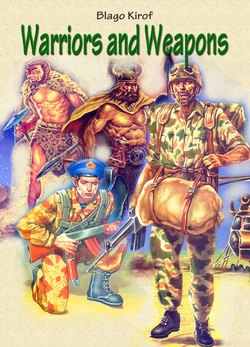Читать книгу Warriors and Weapons - Blago Kirof - Страница 5
На сайте Литреса книга снята с продажи.
Ancient Egypt
ОглавлениеAncient Egypt was an ancient civilization of eastern North Africa, concentrated along the lower reaches of the Nile River in what is now the modern country of Egypt. The civilization coalesced around 3150 BCwith the political unification of Upper and Lower Egypt under the first pharaoh, and it developed over the next three millennia. Its history occurred in a series of stable Kingdoms, separated by periods of relative instability known as Intermediate Periods. Ancient Egypt reached its pinnacle during the New Kingdom, after which it entered a period of slow decline. Egypt was conquered by a succession of foreign powers in this late period, and the rule of the pharaohs officially ended in 31 BC when the early Roman Empire conquered Egypt and made it a province.
For most parts of its long history, ancient Egypt was unified under one government. The main military concern for the nation was to keep enemies out. The arid plains they wanted to get rid of and deserts surrounding Egypt were inhabited by nomadic tribes who occasionally tried to raid or settle in the fertile Nile river valley. Nevertheless the great expanses of the desert formed a barrier that protected the river valley and was almost impossible for massive armies to cross. The Egyptians built fortresses and outposts along the borders east and west of the Nile Delta, in the Eastern Desert, and in Nubia to the south. Small garrisons could prevent minor incursions, but if a large force was detected a message was sent for the main army corps.
The geography of Egypt served to isolate the country and allowed it to thrive. This circumstance set the stage for many of Egypt's military conquests. They weakened their enemies by using small projectile weapons, like bows and arrows. They also had chariots which they used to charge at the enemy.
As early as the Old Kingdom (c.2686-2160 BC) Egypt used specific military units, with military hierarchy appearing in the Middle Kingdom (c.2055-1650 BC). By the New Kingdom (c.1550-1069 BC), the Egyptian military consisted of three major branches: the infantry, the chariotry, and the navy.
Infantry troops were partially conscripted, partially voluntary. Egyptian soldiers worked for pay, both natives and mercenaries.
Projectile weapons were used by the ancient Egyptian army, as well as other period military, as standoff weapons, usually used in order to soften up the enemy prior to an infantry assault. At various times during Egypt's history, different weapons were used, including throw sticks, spears or javelins, bows and arrows and slingshots. Of these, certainly the bow and arrow became the primary projectile weapon for most of Egypt's history, and yet, all of these weapons continued in some use almost throughout the Dynastic period.
Chariotry, the main backbone of the Egyptian army, was introduced into ancient Egypt from Western Asia at the end of the Second Intermediate Period (c.1650-1550 BC) and the beginning of the New Kingdom (c.1550-1069 BC).
Charioteers were drawn from the upper classes in Egypt. Chariots were generally used as a mobile platform from which to use projectile weapons, and were generally pulled by two horses and manned by two charioteers: a driver who carried a shield, and a man with a bow or javelin. Chariots also had infantry support.
The bow and arrow is one of ancient Egypt's most crucial weapons, used from Predynastic times through the end of the Pharaonic period, and of course, much later into the Christian and archaic Islamic periods. Some of the first bows that we know of were the "horn bows", made by joining a pair of antelope horns by a central piece of wood, which were common. During the New Kingdom the composite bow came into use, having been introduced by the Asiatic Hyksos. Often the bows were not made in Egypt itself but imported from the Middle East, as was the case with other 'modern' weapons. The older, single-curved bow was not completely abandoned, however.
In war the spear never gained the importance among Egyptians which it was to have in classical Greece, where phalanxes of spear carrying citizens fought each other. During the New Kingdom it was often an auxiliary weapon of the charioteers, who were thus not left unarmed after spending all their arrows. It was also most useful in their hands when they chased down fleeing enemies stabbing them in their backs.
The spear was appreciated enough to be depicted in the hands of Ramesses III killing a Libyan. It remained short and javelin like, just about the height of a man, unlike the Macedonian lance of later times which was three to four times as long.
